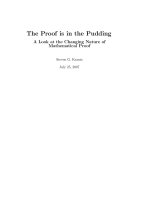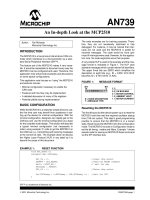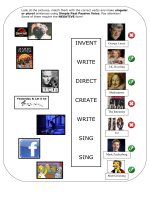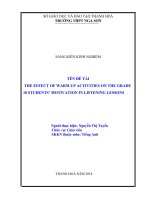unit 15 warm up look at the pictures and tell the name of each activity work in the office go shopping teach children to learn take care family watch tv classify rubbishes unit 15 lesson 1 reading bef
Bạn đang xem bản rút gọn của tài liệu. Xem và tải ngay bản đầy đủ của tài liệu tại đây (641.89 KB, 17 trang )
<span class='text_page_counter'>(1)</span><div class='page_container' data-page=1></div>
<span class='text_page_counter'>(2)</span><div class='page_container' data-page=2>
Warm up:
</div>
<span class='text_page_counter'>(3)</span><div class='page_container' data-page=3>
Work in the office <sub> Go shopping</sub> Teach children to learn
</div>
<span class='text_page_counter'>(4)</span><div class='page_container' data-page=4>
UNIT 15
</div>
<span class='text_page_counter'>(5)</span><div class='page_container' data-page=5>
Before you read
Work in pairs. Look at the pictures and answer
the questions that follow.
1. How many roles does this woman have?
2. Is her life typical of a Vietnamese
</div>
<span class='text_page_counter'>(6)</span><div class='page_container' data-page=6>
While you read
Read the text then do the task that follow.
Vocabulary:
+ Civilization [sivəli'zei∫n](n): Nền văn minh.
+ Deep-seated ['di:p'si:tid](adj): Ăn sâu, lâu đời.
+ Belief [bi'li:f](n): Sự tin tưởng, tín ngưỡng.
+ Childbearing ['t∫aild,beəriη](n): Sự sinh nở.
+ Involvement [in'vɔlvmənt](n): Sự bao gồm, sự tham gia
+ Widespread ['waidspred](adj): Lan rộng, phổ biến
+ Intellectual [,inti'lektjuəl](adj): Thuộc trí tuệ.
+ Enlightenment [in'laitnmənt](n): Sự khai sáng
+ Age of Enlightenment: Thời đại khai sáng
</div>
<span class='text_page_counter'>(7)</span><div class='page_container' data-page=7>
While you read
Task 1: Give the Vietnamese equivalents to the following
words and phrases.
1. Human civilization:
2. Childbearing:
3. Involvement:
4. Age of Enlightenment:
5. Deep-seated cultural beliefs:
6. Homemaking:
7. Intellectual ability:
8. Equal work opportunity:
Nền văn minh nhân loại
Việc sinh con.
Sự tham gia
Thời đại khai sáng
Những niềm tin ăn sâu
vào tiềm
thức.
Việc chăm sóc gia đình
Năng lực trí tuệ
</div>
<span class='text_page_counter'>(8)</span><div class='page_container' data-page=8>
While you read
Task 2: Choose the best option A, B, C, or D to answer the
following questions.
1. According to the text, what was the main role
traditionally accorded to women?
A. working in education.
B. building houses.
C. taking care of the house and family.
D. working in factories.
2. Before the 18th century, what was the attitude of societies
towards women’s intellectual ability?
A. respectful.
B. supportive.
C. resentful.
D. disbelieving.
</div>
<span class='text_page_counter'>(9)</span><div class='page_container' data-page=9>
While you read
Task 2: Choose the best option A, B, C, or D to answer the
following questions.
3. According to the text, what is the purpose of the struggle for
women’s right?
A. to free women from housework.
B. to establish a friendly relationship between men and
women.
C. to bring equality between men and women.
D. to argue that women have better intellectual ability.
4. What do “these pioneer thinkers” at the end of paragraph 2 refer
to?
A. 18th century European people.
B. 18th century European political philosophers.
C. 18th century European women
D. 18th century European politicians
</div>
<span class='text_page_counter'>(10)</span><div class='page_container' data-page=10>
While you read
Task 2: Choose the best option A, B, C, or D to answer the
following questions.
5. Which of the following is NOT mentioned in the last
paragraph as one of women’s legal rights today?
A. the right to hold property.
B. the right to equal pay.
C. equal employment opportunity rights.
D. the right to vote.
</div>
<span class='text_page_counter'>(11)</span><div class='page_container' data-page=11>
While you read
Task 3: Choose the best title for passage.
A. Women’s intellectual Ability.
B. The Age of Enlightenment.
C. Women’s Rights.
D. Women’s Role in Education.
</div>
<span class='text_page_counter'>(12)</span><div class='page_container' data-page=12>
Games
Guessing who she is.
+ Date of birth: 18/ 08/ 1945
+ Place of birth: Tiền Giang.
+ Participating in the revolution:
1967.
+ Vice-chairman of Vietnam:
From 2002 to 2007
</div>
<span class='text_page_counter'>(13)</span><div class='page_container' data-page=13>
Games
Guessing who she is.
+ Date of birth: 26/ 05/ 1927
+ Place of birth: Đồng Tháp.
+ Participating in
the revolution:
From 17 years old.
+ Vice-chairman of Vietnam:
From 1992 to 2002
</div>
<span class='text_page_counter'>(14)</span><div class='page_container' data-page=14>
After you read
Work in pairs. Summarise the reading passage by
writing ONE sentence for each paragraph.
Paragraph 1: In the past, women were limited/restricted
to the role of mothers and wives because of/due to
widespread doubt about their intellectual ability.
Paragraph 2: The struggle for women’s rights began in
the 18th century as European political philosophers
believed that women should be treated equally/should
not be discriminated against on the basis of their sex.
Paragraph 3: Women now enjoy important legal rights
</div>
<span class='text_page_counter'>(15)</span><div class='page_container' data-page=15></div>
<span class='text_page_counter'>(16)</span><div class='page_container' data-page=16>
Homework
</div>
<span class='text_page_counter'>(17)</span><div class='page_container' data-page=17></div>
<!--links-->









